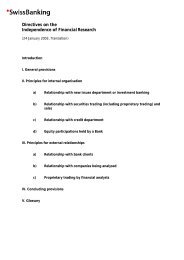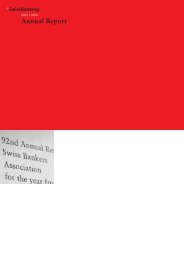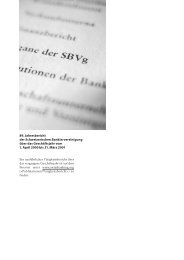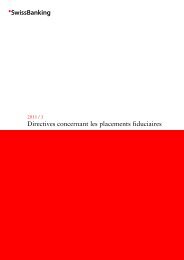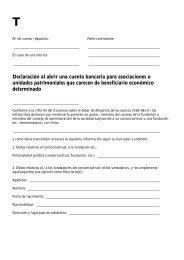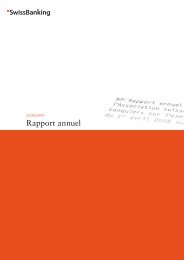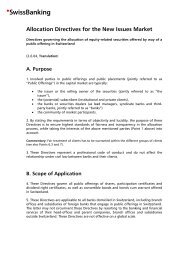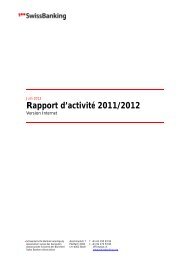Guidelines for the Management of Country Risk Swiss Bankers ...
Guidelines for the Management of Country Risk Swiss Bankers ...
Guidelines for the Management of Country Risk Swiss Bankers ...
Create successful ePaper yourself
Turn your PDF publications into a flip-book with our unique Google optimized e-Paper software.
<strong>Guidelines</strong><br />
<strong>for</strong> <strong>the</strong> <strong>Management</strong> <strong>of</strong> <strong>Country</strong> <strong>Risk</strong><br />
<strong>Swiss</strong> <strong>Bankers</strong> Association
Contents<br />
Introduction 23<br />
I <strong>Country</strong> <strong>Risk</strong> 24<br />
II <strong>Risk</strong> Policy 25<br />
1. Content 25<br />
2. Responsibility 25<br />
3. Minimum Requirements 25<br />
III Recording (Identification and Measurement) 26<br />
1. <strong>Risk</strong> Identification, Measurement, Assessment 26<br />
2. Appropriate Documentation 26<br />
IV <strong>Risk</strong> Limitation and Provisions 27<br />
1. Limit System 27<br />
2. Internal Control System 27<br />
3. Valuation and Provisions 27<br />
V Reporting and Disclosure 28<br />
1. Reporting 28<br />
2. Disclosure 28<br />
VI Audit 29<br />
1. Internal Audit 29<br />
2. External Audit 29<br />
VII Effective Date 29<br />
22
Introduction<br />
Every bank with cross-border (<strong>for</strong>eign) business has to identify, record,<br />
assess, limit and if necessary make value adjustments <strong>for</strong> its own exposure<br />
to risks.<br />
The aim <strong>of</strong> <strong>the</strong>se <strong>Guidelines</strong> is to help banks in setting up <strong>the</strong>ir internal<br />
structures, policies and procedures <strong>for</strong> <strong>the</strong> management <strong>of</strong> country risk.<br />
In no way are <strong>the</strong>y intended to standardise <strong>the</strong> risk management function<br />
at <strong>the</strong> banks, which are free to implement <strong>the</strong> <strong>Guidelines</strong> as <strong>the</strong>y see fit so<br />
long as <strong>the</strong> <strong>Guidelines</strong>’ minimum requirements are met. Basically, <strong>the</strong><br />
methods and systems should follow <strong>the</strong> principle <strong>of</strong> “best practice” and<br />
be appropriate to <strong>the</strong> size and significance <strong>of</strong> <strong>the</strong> <strong>for</strong>eign exposure in<br />
question. The methods employed and <strong>the</strong> degree <strong>of</strong> detail incorporated<br />
into internal directives should be commensurate with <strong>the</strong> volume and<br />
type <strong>of</strong> exposure, i.e. must be adequate <strong>for</strong> <strong>the</strong> risks.<br />
The <strong>Guidelines</strong> apply to all banks reporting to <strong>the</strong> Federal Banking Commission<br />
as supervisory body. For <strong>Swiss</strong> bank groups with domestic and<br />
<strong>for</strong>eign branches and subsidiaries, <strong>the</strong>se <strong>Guidelines</strong> must be implemented<br />
both at <strong>the</strong> level <strong>of</strong> <strong>the</strong> individual institution and group-wide<br />
(consolidated).<br />
If <strong>the</strong> management and control <strong>of</strong> <strong>for</strong>eign exposure fail to meet <strong>the</strong><br />
requirements <strong>of</strong> <strong>the</strong> <strong>Guidelines</strong>, internal structures and procedures must<br />
be adjusted to assure compliance; o<strong>the</strong>rwise <strong>the</strong> activity in question<br />
should be scaled back or abandoned altoge<strong>the</strong>r.<br />
23
I<br />
<strong>Country</strong> <strong>Risk</strong><br />
<strong>Country</strong> risk arises from changes in <strong>the</strong> value <strong>of</strong> <strong>for</strong>eign exposure due to<br />
country-specific political and economic conditions. It consists <strong>of</strong> transfer<br />
risk and “o<strong>the</strong>r country risks”.<br />
• Transfer risk means <strong>the</strong> risk to <strong>the</strong> repatriation <strong>of</strong> <strong>for</strong>eign claims as a<br />
result <strong>of</strong> restrictions over <strong>the</strong> free flow <strong>of</strong> money and capital, or <strong>of</strong> o<strong>the</strong>r<br />
economic or political factors.<br />
• “O<strong>the</strong>r country risks” consists <strong>of</strong> <strong>the</strong> part <strong>of</strong> <strong>the</strong> <strong>for</strong>eign exposure position<br />
whose value depends on <strong>the</strong> economic and political risk factors<br />
prevailing <strong>for</strong> <strong>the</strong> country concerned, independent <strong>of</strong> <strong>the</strong> transfer risk<br />
or credit risk (individual counterparty risk); <strong>the</strong>se factors include in particular<br />
<strong>the</strong> country-specific liquidity, market and correlation risks.<br />
<strong>Country</strong> exposure is understood as total exposure abroad <strong>of</strong> every kind,<br />
including contingent liabilities, irrevocable credit lines, and derivative<br />
instruments, irrespective <strong>of</strong> whe<strong>the</strong>r <strong>the</strong>y are posted to <strong>the</strong> banking book<br />
or <strong>the</strong> trading book.<br />
<strong>Country</strong> risk positions are recorded by risk domicile ra<strong>the</strong>r than <strong>the</strong> domicile<br />
<strong>of</strong> <strong>the</strong> debtor. The risk domicile <strong>of</strong> secured exposure must be<br />
assessed by examining <strong>the</strong> collateral. For <strong>the</strong> definition <strong>of</strong> <strong>the</strong> risk domicile<br />
<strong>the</strong> principles <strong>of</strong> Art. 21e/2–4 <strong>of</strong> <strong>the</strong> Banking Ordinance apply.<br />
Comments:<br />
While classical cross-border loans in <strong>for</strong>eign currency were <strong>the</strong> dominant<br />
feature <strong>of</strong> <strong>the</strong> 1970s and 80s, this was followed by rapid growth in <strong>the</strong><br />
securities and derivative instruments businesses. The partial dependence<br />
<strong>of</strong> <strong>the</strong>se businesses on local economic and market conditions as well as<br />
<strong>the</strong> possibility <strong>of</strong> refinancing <strong>the</strong>m in local currency has led to <strong>the</strong><br />
increasing importance <strong>of</strong> “o<strong>the</strong>r country risks”.<br />
“O<strong>the</strong>r country risks” particularly <strong>the</strong> “country liquidity risk”, could best<br />
be described as a country-specific risk associated with large concentra -<br />
tions <strong>of</strong> exposure or “correlation risk” (“Klumpenrisiko”) analogous to<br />
<strong>the</strong> risk <strong>of</strong> excessive exposure to a single industry. With regard to <strong>for</strong>eign<br />
claims, <strong>the</strong> assessment <strong>of</strong> this risk is <strong>of</strong>ten an integral part <strong>of</strong> <strong>the</strong> counter -<br />
party rating system. In <strong>the</strong> case <strong>of</strong> market risk, <strong>the</strong> country-specific corre -<br />
lation risk must be considered using risk measurement and aggregation<br />
techniques.<br />
Essentially, all <strong>for</strong>eign exposure includes elements <strong>of</strong> “o<strong>the</strong>r country<br />
risks”, while <strong>the</strong> currency <strong>of</strong> denomination and <strong>the</strong> type <strong>of</strong> refinancing<br />
determine whe<strong>the</strong>r a transfer risk exists or not. Thus, <strong>for</strong>eign exposure<br />
which is denominated and refinanced in <strong>the</strong> local (<strong>for</strong>eign) currency will<br />
generally be subject solely to <strong>the</strong> “o<strong>the</strong>r country risks”. Foreign claims<br />
24
denominated in a currency o<strong>the</strong>r than <strong>the</strong> domestic currency <strong>of</strong> <strong>the</strong><br />
debtor will include transfer risk, unless it can reasonably be ascertained<br />
and documented that <strong>the</strong> risk could be transferred.<br />
Exposure recorded in <strong>the</strong> trading book is not exempt from <strong>the</strong> Guide -<br />
lines. However, with regard to provisioning, this exposure might be man -<br />
aged differently, as well as treated differently, than positions in <strong>the</strong> bank -<br />
ing book. Ins<strong>of</strong>ar as <strong>the</strong> management <strong>of</strong> market risk (interest, <strong>for</strong>ex,<br />
equity) is organised by country, it should be considered as part <strong>of</strong> <strong>the</strong><br />
country risk management system. Besides <strong>the</strong> present <strong>Guidelines</strong>, <strong>the</strong><br />
“<strong>Risk</strong> <strong>Management</strong> <strong>Guidelines</strong> <strong>for</strong> Trading and <strong>for</strong> <strong>the</strong> Use <strong>of</strong> Derivatives”<br />
<strong>of</strong> 31 January 1996 apply.<br />
II<br />
<strong>Risk</strong> Policy<br />
1. Content<br />
The risk policy includes, aside from <strong>the</strong> strategy developed <strong>for</strong> assuming<br />
country risks, <strong>the</strong> principles <strong>for</strong> <strong>the</strong> recording (identification and measurement),<br />
management and control <strong>of</strong> country risk, as well as <strong>for</strong> <strong>the</strong><br />
organisational structures.<br />
2. Responsibility<br />
Top management is responsible <strong>for</strong> <strong>the</strong> risk policy in respect <strong>of</strong> country<br />
risk, i.e. <strong>the</strong> board <strong>of</strong> directors in <strong>the</strong> case <strong>of</strong> a company limited by shares.<br />
The senior management (executive board, group executive board, etc.)<br />
<strong>for</strong>mulates <strong>the</strong> risk policy, which is to be approved and periodically<br />
assessed <strong>for</strong> its suitability by <strong>the</strong> board <strong>of</strong> directors. Senior management<br />
issues instructions <strong>for</strong> <strong>the</strong> implementation <strong>of</strong> <strong>the</strong> risk policy and delegates<br />
authority <strong>for</strong> <strong>the</strong> assumption <strong>of</strong> risks. Adherence to <strong>the</strong>se regulations<br />
is to be monitored.<br />
3. Minimum Requirements<br />
<strong>Country</strong> risk must be identified, measured, assessed, limited and controlled<br />
by all banks. The scope, degree <strong>of</strong> detail, and systems and methods<br />
must be appropriate to <strong>the</strong> extent <strong>of</strong> <strong>the</strong> business activities and <strong>the</strong>ir<br />
associated risks. There must be an adequate internal control system.<br />
Comments:<br />
Questions <strong>of</strong> risk management, and in particular key decisions on risk<br />
policy and its periodic review, are among <strong>the</strong> fundamental leadership<br />
tasks.<br />
25
Persons who are entrusted with daily risk management and control tasks<br />
must possess <strong>the</strong> necessary qualifications.<br />
The minimum requirements <strong>for</strong> <strong>the</strong> risk policy pursued (according to II/3),<br />
which will be discussed in more detail in <strong>the</strong> following paragraphs, only<br />
constitute an outline <strong>of</strong> what must be accomplished by <strong>the</strong> banks’ own<br />
structures and processes. Basically, an adequate system <strong>of</strong> country risk<br />
management must be put in place, a system designed to provide <strong>the</strong><br />
management and control functions with a sufficiently high standard <strong>of</strong><br />
precision given <strong>the</strong> level <strong>of</strong> country exposure.<br />
III Recording<br />
(Identification and Measurement)<br />
1. <strong>Risk</strong> Identification, Measurement, Assessment<br />
Each bank must be in a position to identify country risk exposure and<br />
monitor <strong>the</strong> per<strong>for</strong>mance <strong>of</strong> <strong>the</strong>se positions. The assessment <strong>of</strong> country<br />
risk should be uni<strong>for</strong>m within a bank and be appropriate to <strong>the</strong> size <strong>of</strong> <strong>the</strong><br />
exposure. The basis <strong>for</strong> this could be <strong>the</strong> bank’s own country risk analyses<br />
(e.g. including classification into rating categories) or accepted externally<br />
available country assessments.<br />
Banks with considerable <strong>for</strong>eign exposure and considerable country risk<br />
have to periodically review <strong>the</strong> influence <strong>of</strong> potential credit deterioration,<br />
or payment problems <strong>of</strong> specific countries or groups <strong>of</strong> countries, on<br />
<strong>the</strong>ir balance sheet and P&L per<strong>for</strong>mance. The findings must be brought<br />
to <strong>the</strong> attention <strong>of</strong> <strong>the</strong> senior management <strong>of</strong>ficers responsible.<br />
2. Appropriate Documentation<br />
Foreign exposure, risk assessments and, where necessary, <strong>the</strong> results <strong>of</strong><br />
periodic stress tests should be appropriately documented.<br />
Comments:<br />
<strong>Risk</strong> identification and measurement means in <strong>the</strong> first instance that <strong>the</strong><br />
size <strong>of</strong> <strong>the</strong> exposure per country can be adequately determined. Fur<strong>the</strong>r -<br />
more, <strong>the</strong> risk on this exposure must be determined on <strong>the</strong> basis <strong>of</strong> inter -<br />
nal or external rating systems. Banks with substantial <strong>for</strong>eign exposure<br />
can be expected to provide quantitative estimates <strong>of</strong> potential losses in<br />
<strong>the</strong> event <strong>of</strong> default and to ascertain <strong>the</strong> probability <strong>of</strong> default on a port -<br />
folio basis, while simple assessments <strong>of</strong> <strong>the</strong> probability <strong>of</strong> loss and <strong>the</strong><br />
potential loss on default on a country-by-country basis will be sufficient<br />
<strong>for</strong> banks with little <strong>for</strong>eign exposure.<br />
26
In-house country ratings, particularly those produced by banks with<br />
extensive <strong>for</strong>eign exposure, <strong>of</strong>ten reflect a very good knowledge <strong>of</strong> <strong>the</strong><br />
countries studied. However, where <strong>the</strong>re are significant differences<br />
between <strong>the</strong> internal and externally available ratings, a clarification <strong>of</strong> <strong>the</strong><br />
differences is indispensable, both as a quality control measure and to<br />
avoid conflicts <strong>of</strong> interest within <strong>the</strong> bank.<br />
Banks with exposure in developing countries and emerging markets<br />
have to simulate <strong>the</strong> effects <strong>of</strong> extreme credit deterioration by conducting<br />
stress tests, if <strong>the</strong> risk exposure is substantial in relation to <strong>the</strong>ir equity<br />
base and P&L.<br />
IV <strong>Risk</strong> Limitation and Provisions<br />
1. Limit System<br />
Banks with <strong>for</strong>eign exposure must have an adequate limit system in<br />
place <strong>for</strong> country risk. The limits must be regularly reviewed and authorised<br />
by <strong>the</strong> senior management function designated <strong>for</strong> that purpose.<br />
2. Internal Control System<br />
The banks are obliged to have adequate in<strong>for</strong>mation systems to monitor<br />
compliance with country risk limits. It must be possible to detect a limit<br />
violation in good time and this should result in a report to higher authorities.<br />
The employees who are entrusted with <strong>the</strong> controlling function<br />
must have <strong>the</strong> required knowledge and must be sufficiently independent<br />
from <strong>the</strong> staff whose work <strong>the</strong>y are assigned to monitor.<br />
3. Valuation and Provisions<br />
The banks make adequate value adjustments, on <strong>the</strong> basis <strong>of</strong> <strong>the</strong>ir own<br />
valuation principles (it being understood that <strong>the</strong>se principles must be<br />
compatible with <strong>of</strong>ficial regulations). <strong>Country</strong> risk, value adjustments and<br />
provisions must be recorded in such a way that <strong>the</strong>y can easily be<br />
reviewed by <strong>the</strong> auditors.<br />
In addition, banks decide <strong>for</strong> <strong>the</strong>mselves on <strong>the</strong>ir own provisioning<br />
against future unexpected losses on <strong>the</strong> basis <strong>of</strong> <strong>the</strong>ir internal risk models<br />
and, <strong>of</strong> course, within <strong>the</strong> scope <strong>of</strong> <strong>the</strong> current accounting rules (e.g.<br />
reserves <strong>for</strong> cyclical fluctuations).<br />
Comments:<br />
The rapid pace <strong>of</strong> change in <strong>the</strong> international political and economic envi -<br />
ronment make it essential to subject <strong>the</strong> adequacy <strong>of</strong> <strong>the</strong> country limits to<br />
regular review. And checks must be made on a daily basis to assure that<br />
27
country limits are not violated. Rules have to be defined <strong>for</strong> limit<br />
excesses as well as rules <strong>for</strong> approving excesses.<br />
Differences can appear in valuation and provisioning <strong>of</strong> operations in <strong>the</strong><br />
banking book as compared to <strong>the</strong> trading book. In both cases, however,<br />
<strong>the</strong> benefits <strong>of</strong> diversification can be taken into account when deciding on<br />
provisioning (<strong>for</strong> unexpected losses).<br />
Value adjustments that go beyond <strong>the</strong> amount necessary are considered<br />
hidden reserves. They are not allowed in group accounting (consolidated<br />
accounts). In <strong>the</strong> accounts <strong>of</strong> a single entity (company, autonomous divi -<br />
sion) <strong>the</strong>y are to be shown under “o<strong>the</strong>r provisions”.<br />
Additional provisioning in <strong>the</strong> <strong>for</strong>m <strong>of</strong> “reserves <strong>for</strong> cyclical fluctuations”<br />
can be made if <strong>the</strong> preconditions laid down in <strong>the</strong> RRV (Bank Accounting<br />
<strong>Guidelines</strong>) are fulfilled.<br />
V Reporting and Disclosure<br />
1. Reporting<br />
<strong>Country</strong> risk exposure as well as comments on large differences between<br />
<strong>the</strong> bank’s own ratings and externally available country assessments<br />
must be part <strong>of</strong> <strong>the</strong> bank's risk reporting. This reporting must also include<br />
regular country risk reports, no later than <strong>the</strong> end <strong>of</strong> each reporting<br />
period, to <strong>the</strong> board <strong>of</strong> directors or o<strong>the</strong>r corporate authority determined<br />
by <strong>the</strong> board <strong>of</strong> directors. Extraordinary changes must be reported immediately.<br />
2. Disclosure<br />
The <strong>for</strong>eign exposure (countries grouped by risk class) must be published<br />
in <strong>the</strong> annual report, if this is important <strong>for</strong> assessing <strong>the</strong> asset<br />
value and quality <strong>of</strong> earnings <strong>of</strong> <strong>the</strong> bank. The rating system used must<br />
be explained. The use <strong>of</strong> international standards as a guideline is recommended.<br />
Comments:<br />
Foreign exposure based on risk domicile and grouped by country rating<br />
must be disclosed in <strong>the</strong> appendix (notes) to <strong>the</strong> annual report, along<br />
with explanations <strong>of</strong> <strong>the</strong> country rating applied. This disclosure, which is<br />
organised by risk domicile, must not be confused with <strong>the</strong> reporting<br />
organised by <strong>the</strong> debtors' domicile (Table J).<br />
28
VI Audit<br />
1. Internal Audit<br />
The internal audit function will particularly check <strong>the</strong> risk policy, risk management<br />
and control <strong>of</strong> country risk <strong>for</strong> compliance.<br />
2. External Audit<br />
The statutory auditors examine whe<strong>the</strong>r <strong>the</strong>se <strong>Guidelines</strong> have been<br />
adhered to, basing <strong>the</strong>ir work as far as is both possible and useful on <strong>the</strong><br />
work <strong>of</strong> <strong>the</strong> internal audit function. They record <strong>the</strong> audit results in <strong>the</strong><br />
ordinary audit report (to <strong>the</strong> Federal Banking Commission).<br />
VII Effective Date/Transition Period<br />
The <strong>Guidelines</strong> were approved by <strong>the</strong> Board <strong>of</strong> Directors <strong>of</strong> <strong>the</strong> <strong>Swiss</strong><br />
<strong>Bankers</strong> Association on 4 September 1997, taking effect from 31 December<br />
1997. There will be a transitional period until 31 December 1999, during<br />
which <strong>the</strong> current Federal Banking Commission regulations on minimum<br />
provisions <strong>for</strong> country risk (EBK-RS 92/4) can be applied.<br />
Basle, November 1997<br />
SWISS BANKERS ASSOCIATION<br />
29



